This gluten free Garden Vegetable Lasagna is full of healthy summer veggies! It's made with ricotta cheese, eggplant, zucchini, and spinach.
Lasagna is delicious in all forms but during the summer months I love a good Vegetarian Lasagna. It's the perfect way to utilize fresh garden veggies!
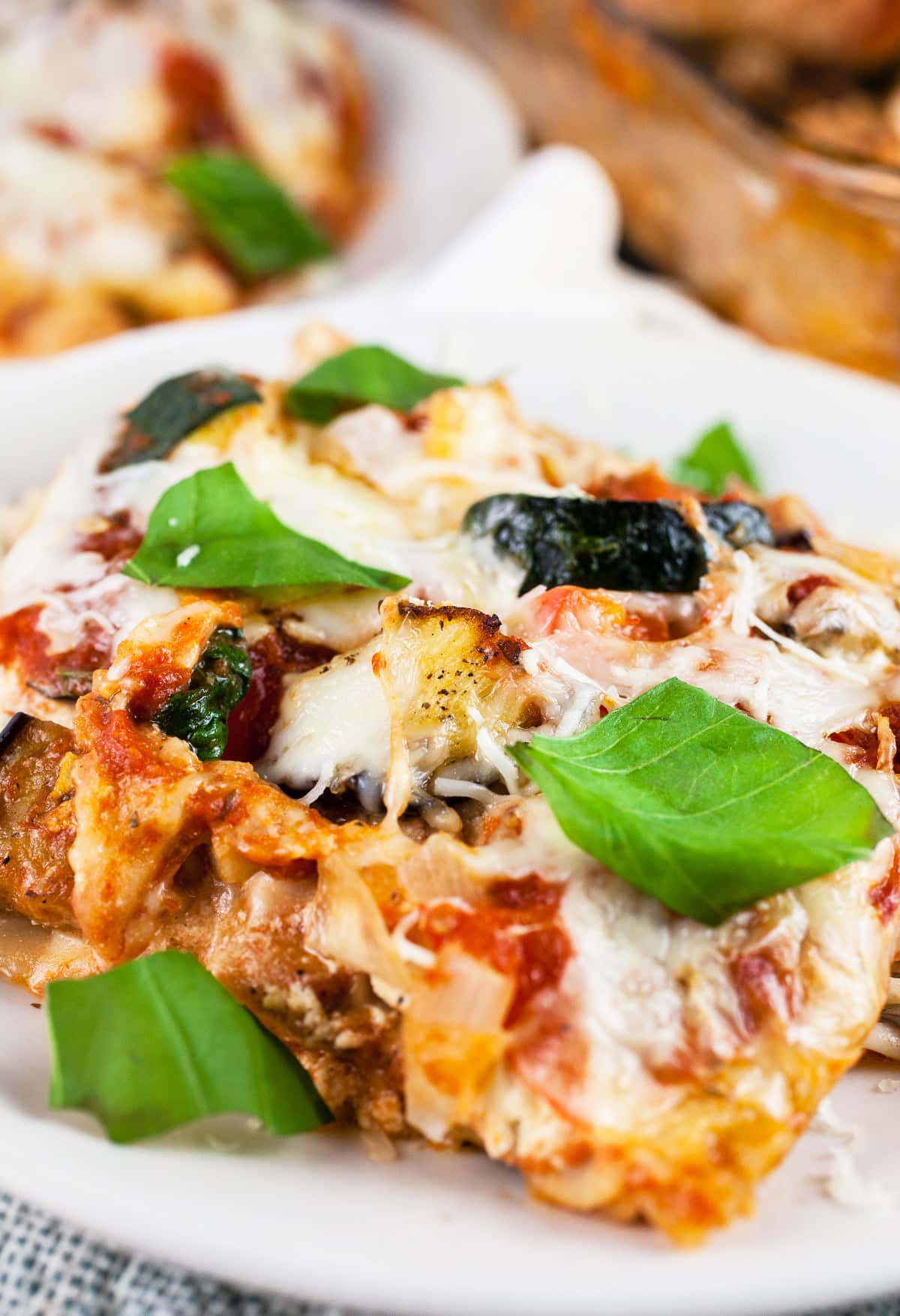
One of my favorite things about the summer months is the process of planting a garden. I love to plant the seeds, water and weed the garden, and watch the vegetables and herbs grow taller throughout the season.
There is nothing better than walking out to the garden, picking some fresh veggies and herbs, and creating a healthy and flavorful dish with them. This lasagna is great because it's packed with seasonal vegetables.
It's got roasted eggplant, bell peppers, zucchini, and spinach sautéed with garlic and onions, and an herbed ricotta mixture baked in a casserole dish with lasagna noodles, marinara sauce, and mozzarella and Parmesan cheese.
This dish is the perfect example of vegetarian Italian inspired comfort food. It's hearty enough that you won't even miss the meat.
Jump to:
- Which Vegetables Are Good For Vegetable Lasagna?
- Ingredients For Garden Vegetable Lasagna
- Which Gluten Free Noodles Are Best For Lasagna?
- How To Roast The Eggplant
- How To Make Garden Vegetable Lasagna
- How To Make The Ricotta Cheese Mixture
- How To Assemble Vegetable Lasagna
- How Long Does Vegetarian Lasagna Take To Bake?
- What To Serve With Vegetable Lasagna
- Can Vegetarian Lasagna Be Made The Day Ahead?
- How Long Does It Last In The Fridge?
- Can It Be Frozen?
- Garden Vegetable Lasagna (Gluten Free)
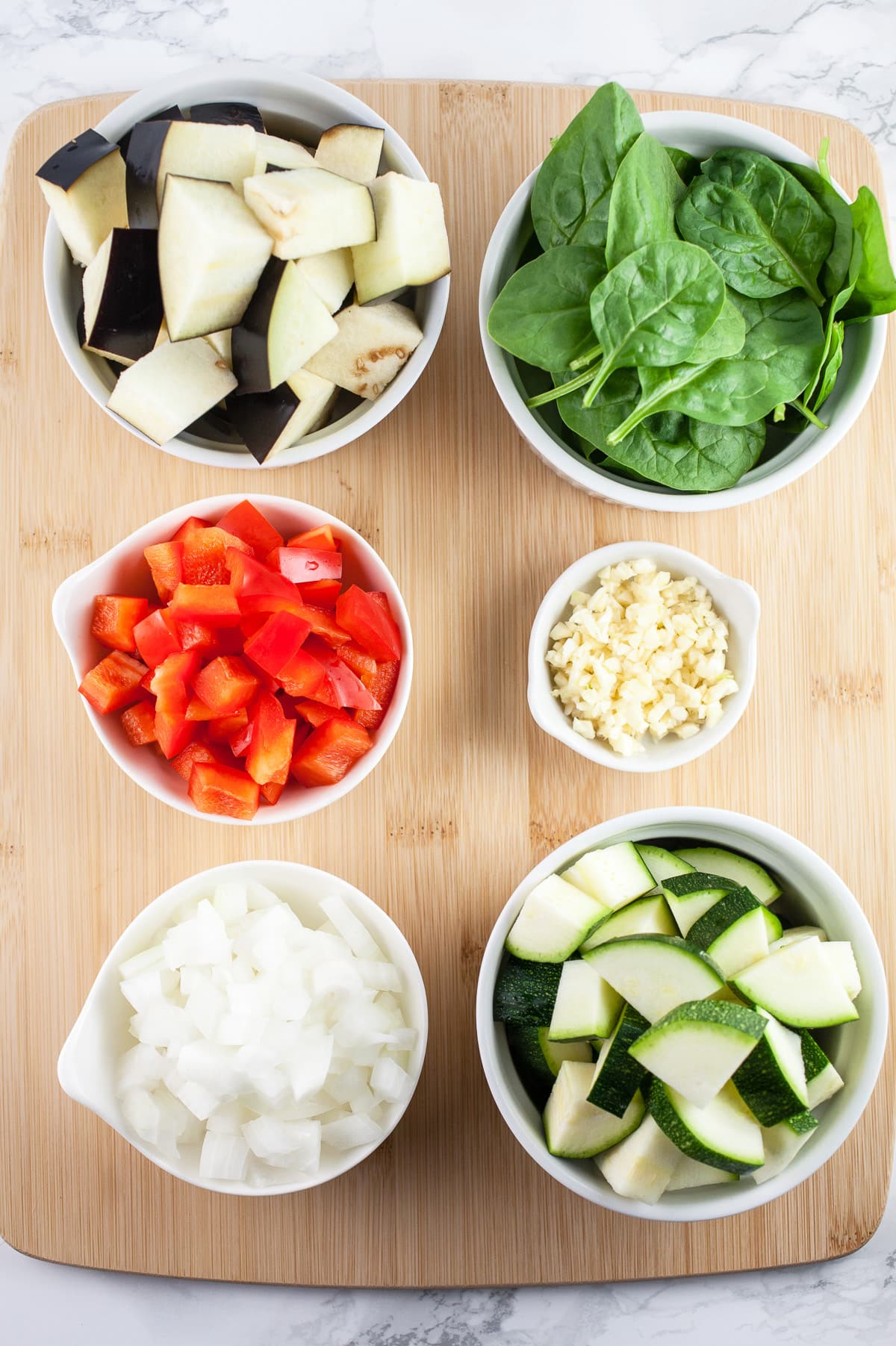
Which Vegetables Are Good For Vegetable Lasagna?
This Garden Vegetable Lasagna does contain a lot of veggies and there is some effort involved on the front end but I promise all that chopping is worth it.
I recommend using fresh instead of frozen vegetables as frozen veggies have a high water content and may result in lasagna that is watery or soggy.
Vegetable lasagna is versatile in that you can use just about any fresh veggies you like. I recommend opting for vegetables with a low water content in addition to those with a similar cooking time.
Vegetables that are great for vegetarian lasagna include zucchini or summer squash, bell or banana peppers, spinach or hearty greens like kale, carrots, onions, mushrooms, and eggplant.
One of my favorite veggies (although it is technically a fruit) is eggplant (also known as aubergine). Eggplant has a naturally 'meaty' texture and tends to pick up the flavor of whatever is added to it.
The eggplant in this recipe is roasted, which helps to provide structure to the lasagna and prevents it from becoming too watery or greasy.
Ingredients For Garden Vegetable Lasagna
Here's what you'll need to make it.
- 6 cloves Garlic
- 1 Onion (any color)
- 1 Bell Pepper (any color)
- 1 medium Zucchini or Summer Squash (yields 2 cups chopped)
- 1 medium Eggplant (yields 6 cups chopped)
- 2 packed cups Spinach
- 6 Tbsp. Olive Oil (split)
- 1 ¼ tsp. each Kosher Salt and Pepper (split)
- 1 package Gluten Free Lasagna Noodles (or regular lasagna noodles if not gluten free)
- 7 oz. Ricotta Cheese (equals 2 cups)
- 1 Egg
- ½ tsp. Italian Seasoning
- 1 24 oz. jar Marinara Sauce
- 8 oz. Mozzarella Cheese (shredded)
- ½-1 cup Parmesan or Asiago Cheese (shredded)
- Fresh Basil for garnish
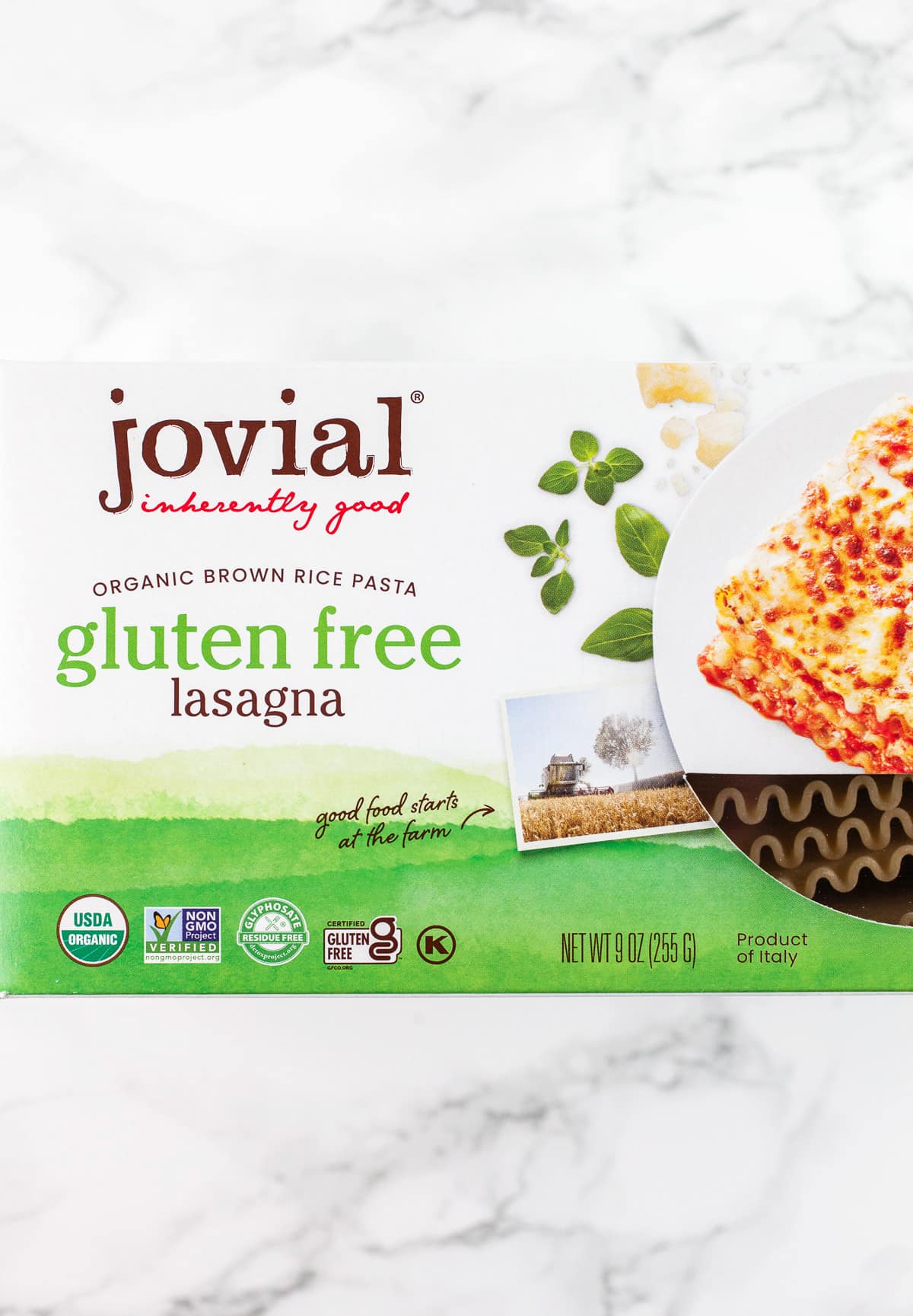
Which Gluten Free Noodles Are Best For Lasagna?
When making gluten free lasagna (or any gluten free pasta), it's important to choose a high quality brand of pasta that will hold up to the cooking process without becoming mushy.
I recommend a brand of lasagna noodles that are made with brown rice, such as those from Jovial or Tinkyada. Brown rice noodles maintain their structure and do not become as mushy as those made with corn.
Alternately, you can try a brand of oven-ready gluten free lasagna noodles.
Here are a few tips that I have discovered to achieve success when making gluten free lasagna noodles.
- Cook the lasagna noodles just until al dente. It's very important not to overcook gluten free noodles of any kind, or they will become mushy and fall apart.
- After the lasagna noodles have cooked just until al dente, place them in a strainer in the sink and rinse under cold water. This will help stop the cooking process and remove any excess starch that may cause the noodles to become gummy.
- Make sure that the cooked and rinsed noodles have drained and dried out a bit before using them to layer the lasagna. This helps to prevent the lasagna from becoming watery.
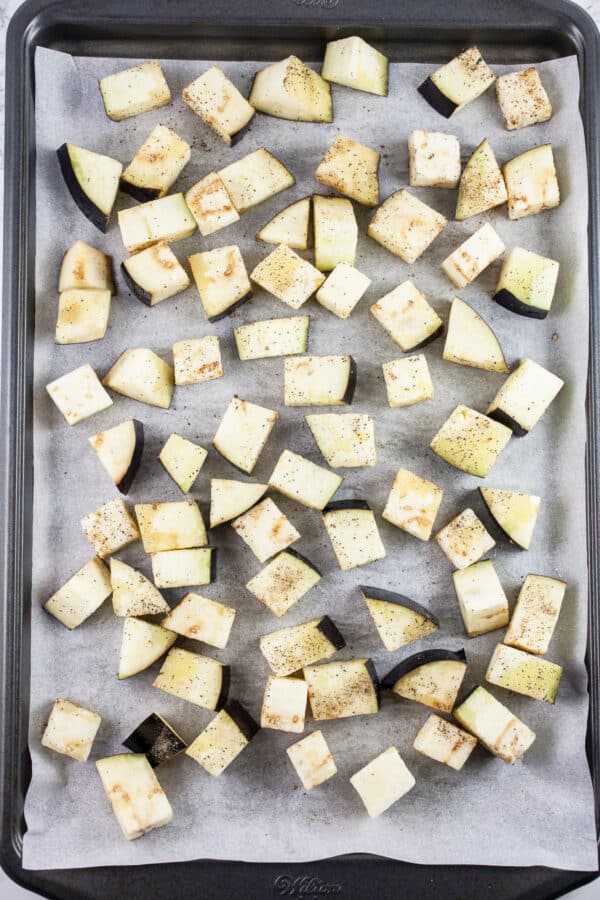
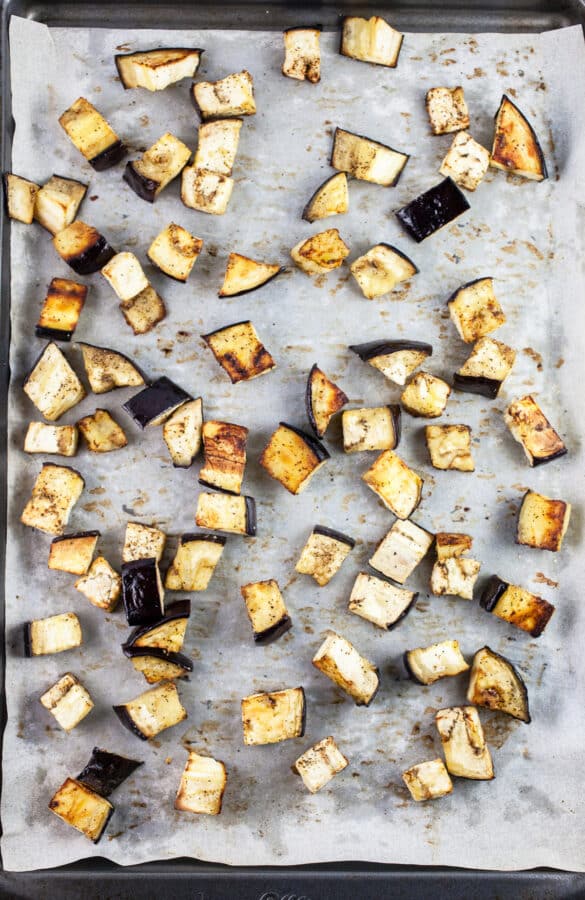
How To Roast The Eggplant
This recipe was originally written with the eggplant sautéed in a skillet along with the rest of the vegetables. I tested it by roasting the eggplant in the oven and enjoyed it so much, decided to re-write the recipe to reflect the change.
The process of roasting the eggplant helps to bring out its natural flavors. It also helps the diced eggplant to hold its shape a bit better, creating more of a meaty texture.
It also helps to cut down on overall cooking time, which is great because making vegetable lasagna is a lengthy process.
This recipe calls for 1 medium Italian eggplant (the variety that is available in most supermarkets) and yields roughly 6 cups of diced eggplant.
There is no need to peel or salt the eggplant before cooking.
- Start by heating the oven to 400 degrees Fahrenheit.
- Cut both the top and bottom off 1 Italian eggplant and discard.
- Dice the eggplant into chunks, making sure that they are relatively the same size to ensure that they cook evenly (yields 6 cups diced).
- Line a large baking sheet with parchment paper and place the diced eggplant onto the baking sheet.
- Drizzle the diced eggplant with 3 Tbsp. of olive oil and sprinkle ¾ tsp. each of kosher salt and pepper over it.
- Toss the eggplant until completely coated in the oil and spices.
- Place the baking sheet in the oven and roast for 20 minutes.
- Remove the baking sheet after roasting and set aside to cool.
Love eggplant? Check out this Gluten Free Eggplant Parmesan, Smoky Baba Ghanoush, Grilled Eggplant Sandwiches, and Air Fryer Eggplant Parmesan Fries!
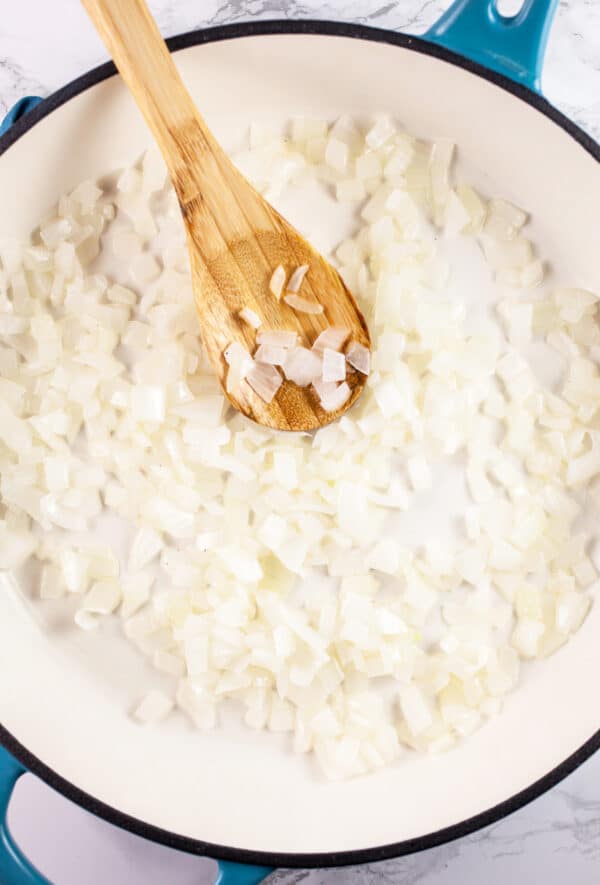
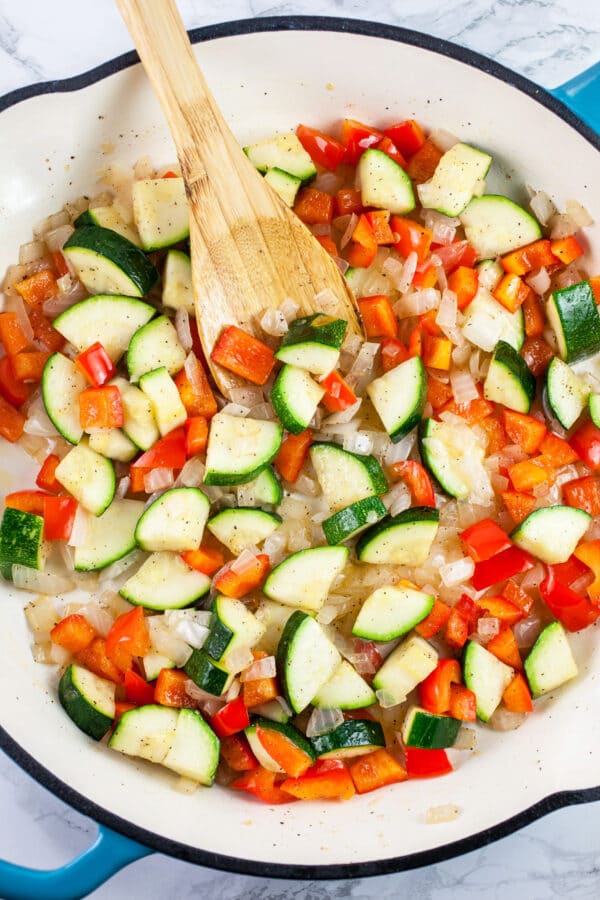
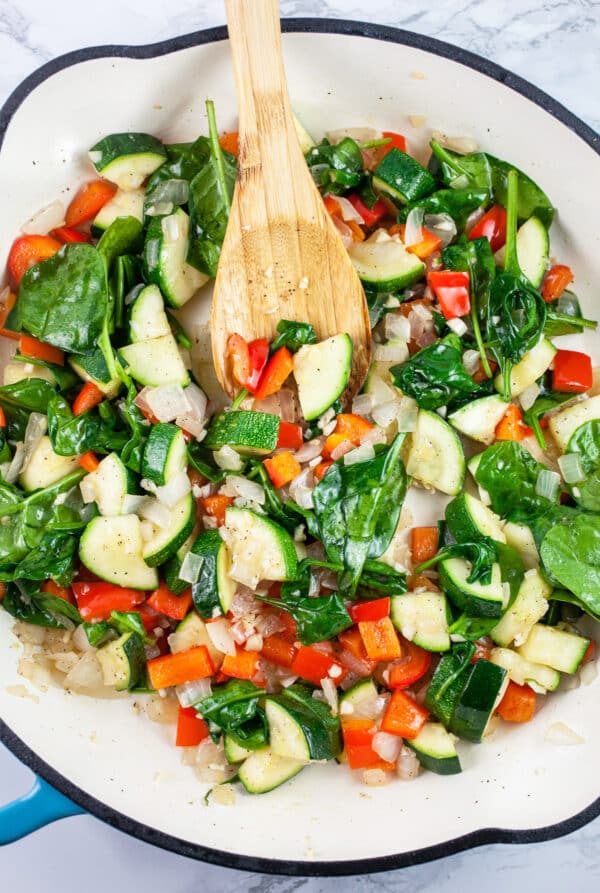
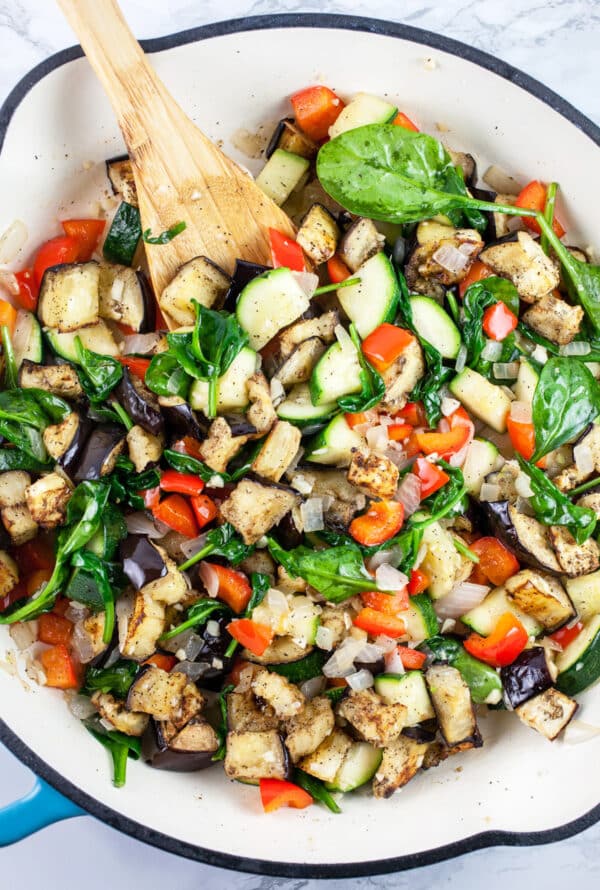
How To Make Garden Vegetable Lasagna
While the eggplant is roasting in the oven, this is a great time to mince the rest of the veggies and to boil the lasagna noodles.
This helps to ensure that all of the elements of the dish are ready at the same time and makes the whole thing easier to assemble.
- Place a large pot of water on the stove top and bring to a boil.
- Once boiling, prepare 1 package of gluten free lasagna noodles (or regular lasagna noodles if not gluten free) according the package instructions, cooking just until al dente.
- Once the noodles are al dente, remove them from the boiling water and transfer them to a strainer in the sink. Rinse the noodles with cold water to stop the cooking process. Set aside.
- Mince 6 cloves of garlic and 1 onion (any color).
- Dice 1 bell pepper (any color).
- Dice 1 medium zucchini or summer squash. Make sure that the zucchini is cut relatively the same size to ensure that it cooks evenly.
- Place a large skillet on the stove top and heat to medium-high.
- Once heated, add 2 Tbsp. olive oil. Once the oil is heated, add the minced onions. Sauté the onions for 5-6 minutes or until translucent, stirring often.
- Add the diced bell peppers and zucchini or summer squash, along with ¼ tsp. each of kosher salt and pepper. Sauté the veggies for 8-10 minutes, stirring often.
- Add the minced garlic and 2 packed cups of fresh spinach to the skillet. Sauté for 2-3 minutes or until the spinach wilts slightly and the garlic is fragrant, stirring often.
- Add the roasted eggplant to the skillet and stir until completely combined.
At this point all the veggies should be soft but not mushy.
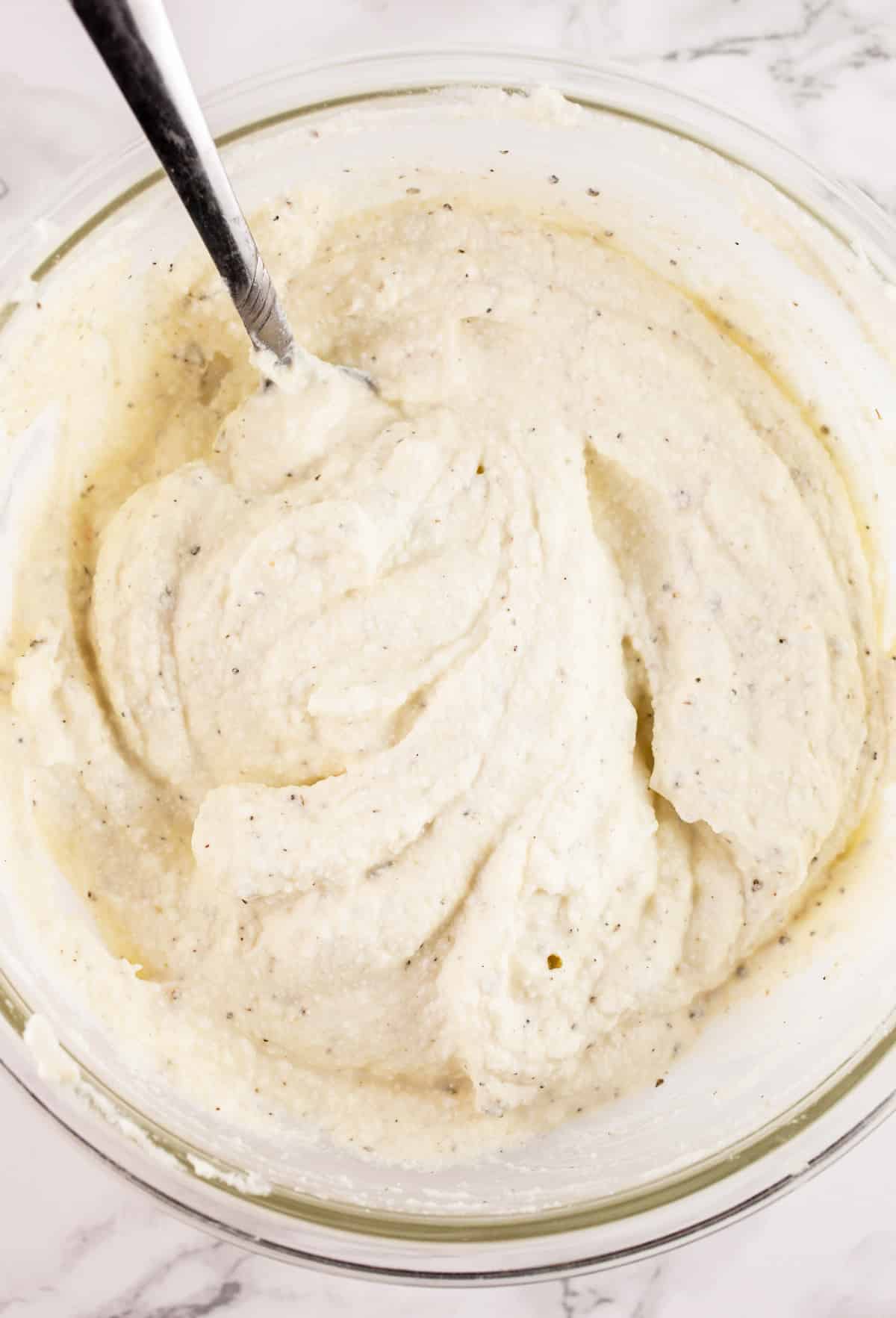
How To Make The Ricotta Cheese Mixture
Lasagna is often layered with a cheese mixture that helps to bind it together. Often, it's made with either ricotta or cottage cheese along with an egg that works as a binder. This vegetable lasagna recipe uses ricotta cheese.
Ricotta is a cheese that was created in Italy as a way to use up the whey that is produced during the cheese-making process.
It has a fresh taste and is smooth but a little grainy at the same time (it resembles cottage cheese). You can find ricotta cheese in the dairy section of your local grocery store.
- To make the ricotta cheese mixture, place 7 oz. (or 2 cups) of full-fat ricotta cheese into a small bowl.
- Add 1 egg, ½ tsp. Italian seasoning, and ¼ tsp. each of kosher salt and pepper.
- Stir all of the ingredients until completely combined.
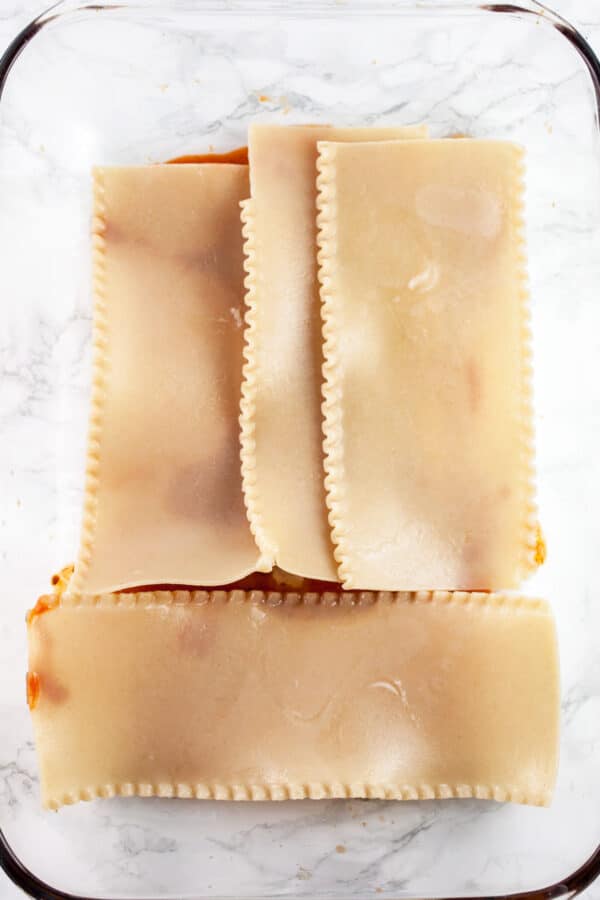
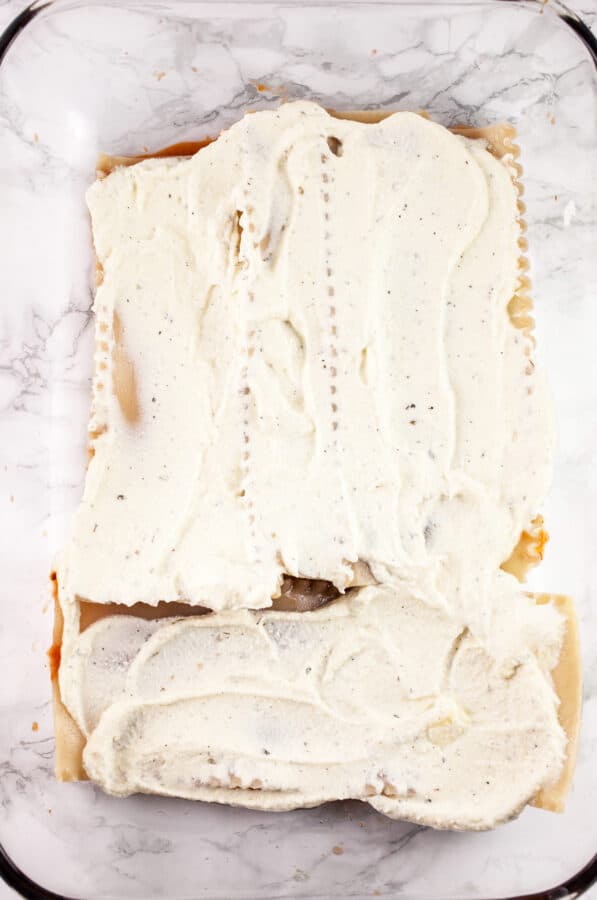
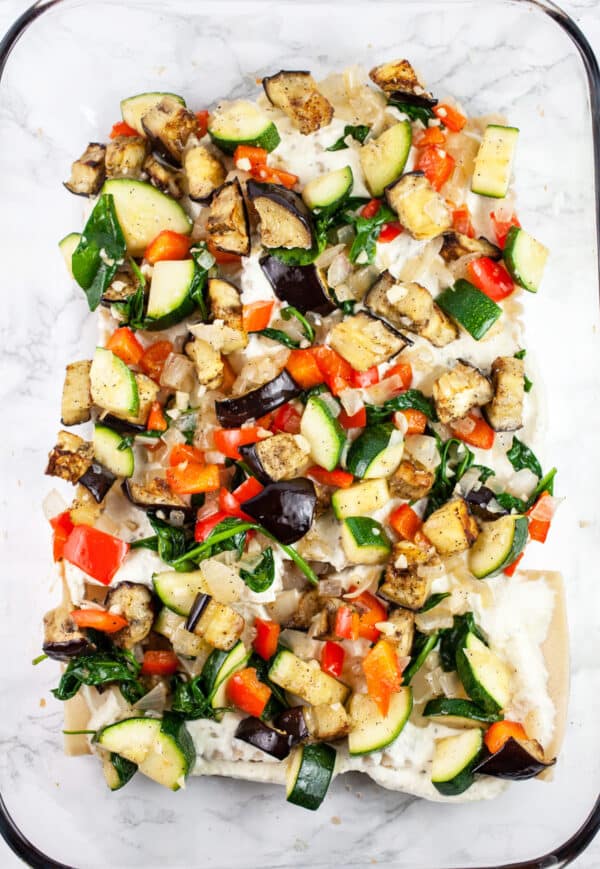
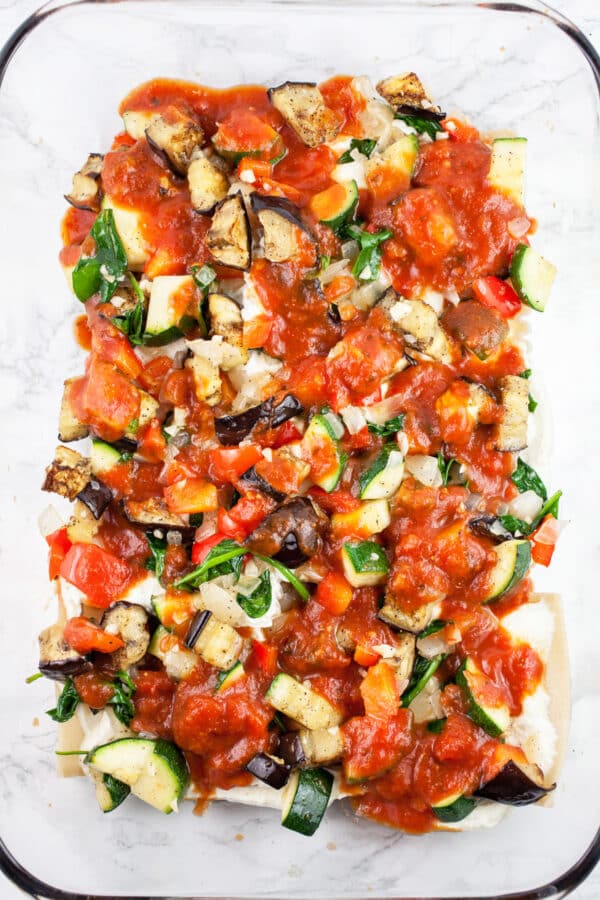
How To Assemble Vegetable Lasagna
After the noodles, veggies, and cheese mixture are prepared, it's time to assemble the vegetable lasagna in a baking pan.
I recommend a 9x13 inch glass or ceramic baking dish or a non-reactive metal baking dish. If using a metal baking dish without a protective coating, the acid from the tomatoes may cause the baking dish to discolor in the cooking process.
- Start by lowering the heat of the oven down to 350 degrees Fahrenheit.
- Shred 8 oz. of mozzarella cheese (or any variety of cheese that melts nicely such as provolone or fontina) along with 1 cup of Parmesan, Asiago, or Romano cheese.
- Pour 1 Tbsp. of olive oil into the bottom of a 9x13 inch baking dish and spread it around evenly (this will prevent the noodles from sticking to the surface).
- Pour ⅓ jar of your favorite 24 oz. jar of marinara sauce on top of the oil. This layer of sauce helps to keep the bottom of the lasagna moist.
- Place a layer of the cooked lasagna noodles evenly across the bottom of the dish.
- Spread half of the ricotta mixture over the first layer of lasagna noodles.
- Place half of the sautéed vegetable mixture evenly over the layer of ricotta cheese.
- Pour another ⅓ of the marinara sauce evenly over the sautéed veggies.
- Spread half of the shredded mozzarella and Parmesan cheese evenly over the vegetable mixture.
- Repeat the process again, adding another layer of cooked lasagna noodles, the rest of the ricotta cheese mixture, the remaining sautéed veggies, the rest of the marinara sauce, and the remainder of the shredded cheeses over the top of the lasagna.
Whew - Time for a glass of wine!
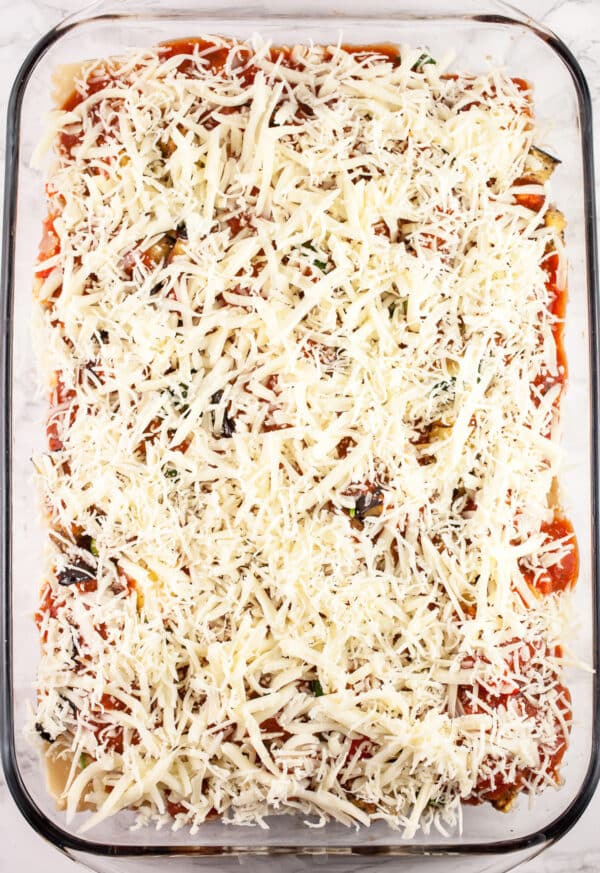
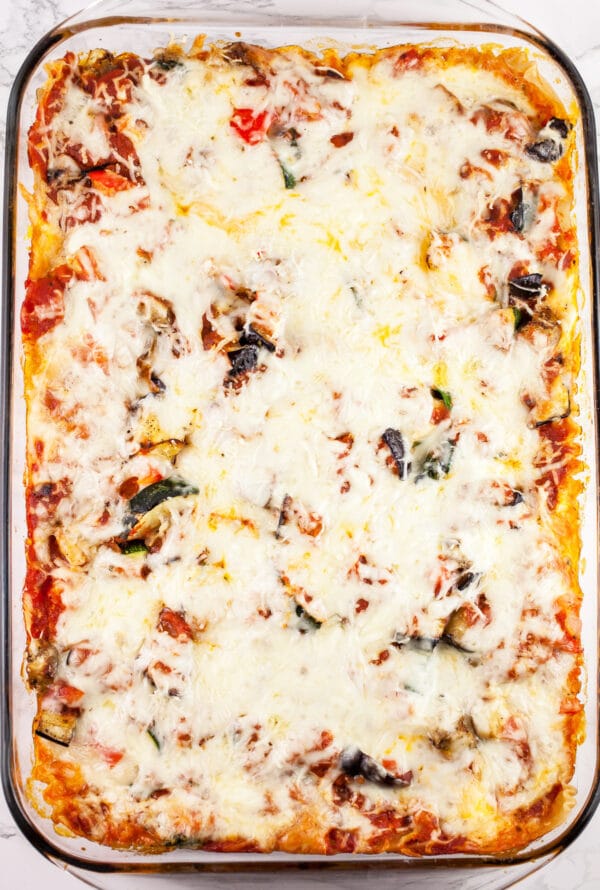
How Long Does Vegetarian Lasagna Take To Bake?
Once the lasagna is assembled it's time to bake it in the oven.
It's first covered with aluminum foil and baked for 350 degrees Fahrenheit. The foil is then removed and the lasagna is baked for another 15 minutes. This helps the cheese on top of the lasagna to become golden brown.
- Fold a piece of aluminum foil tightly around the baking dish.
- Place the baking dish in the oven and bake for 30 minutes at 350 degrees Fahrenheit.
- After 30 minutes, remove the foil and bake for another 15 minutes.
- Remove the baking dish from the oven and allow the vegetable lasagna to cool for 10-15 minutes before cutting into it. This will allow some of the water to dissipate and the lasagna will hold together better when serving.
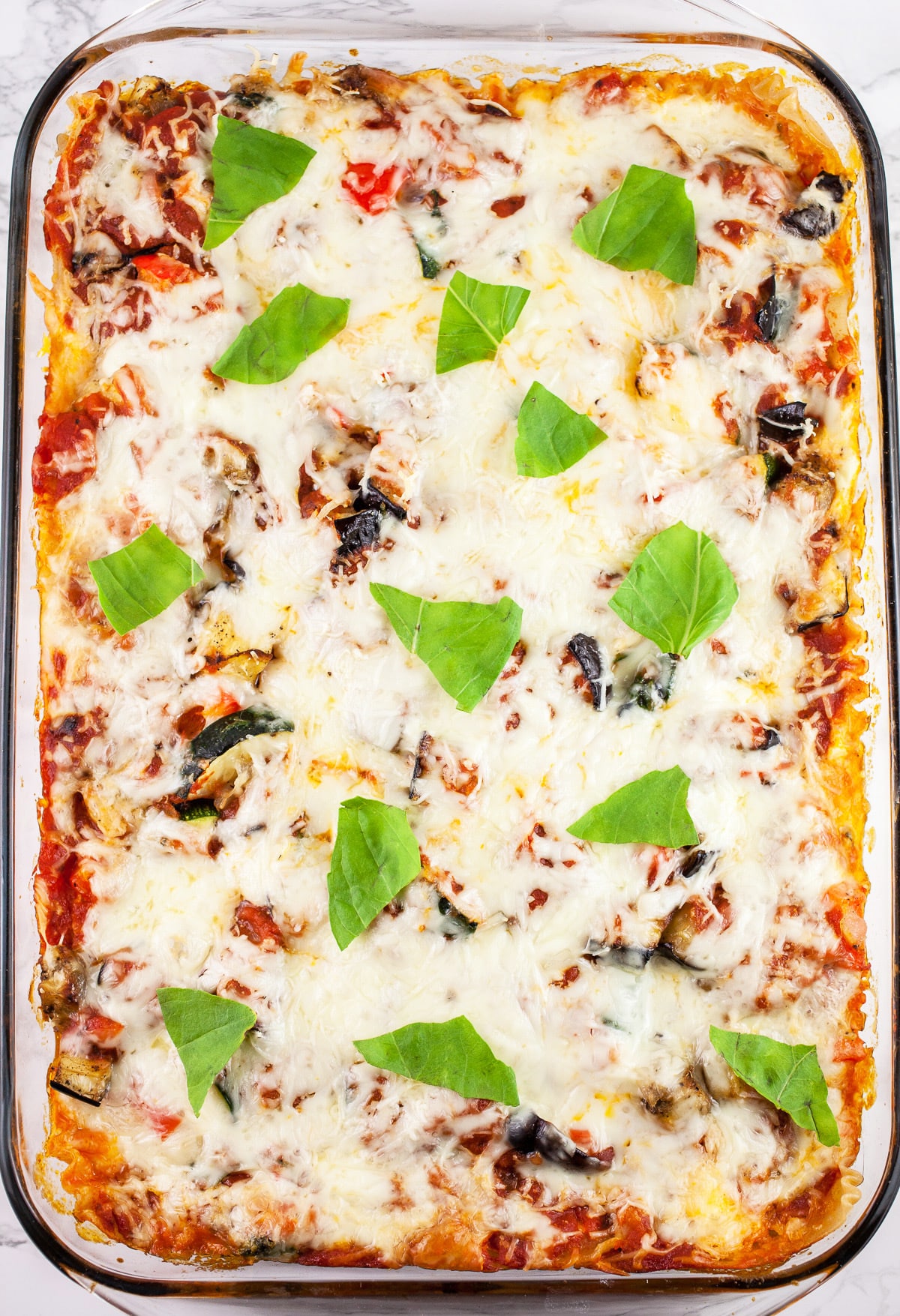
What To Serve With Vegetable Lasagna
This Garden Vegetable Lasagna is a pretty hearty meal and can certainly be enjoyed on its own.
I recommend serving this lasagna with some freshly torn basil leaves. You can also use fresh parsley if you prefer. Feel free to add some extra grated Parmesan, Asiago, or Romano cheese.
I love decadent Italian dishes like this one paired with a bright and tangy side salad or Caesar salad.
It's also great with this Italian green bean salad, marinated tomato salad, pickled beet salad, or Italian quinoa salad.
A simple side dish like these roasted green beans or Parmesan roasted cauliflower is a nice pairing.
This Kalamata olive tapenade or mushroom tapenade makes for a great flavorful appetizer.
For an irresistible Italian dessert, check out this Italian chocolate hazelnut cake, pistachio panna cotta, or strawberry mint panna cotta.
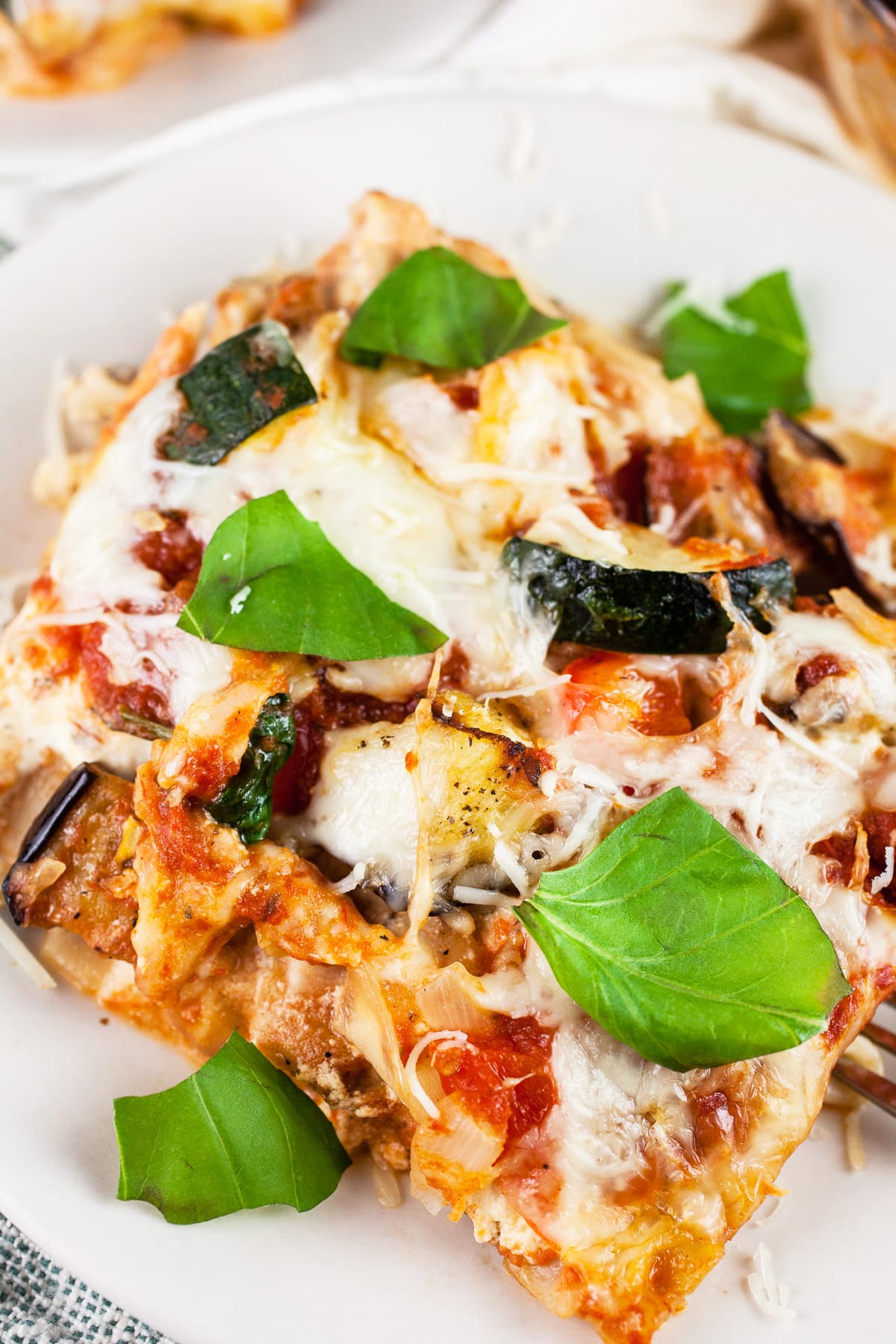
Can Vegetarian Lasagna Be Made The Day Ahead?
Yes, this lasagna can be made the day ahead!
- To make the day ahead, simply prepare the recipe as directed, omitting the fresh basil leaves.
- Allow the lasagna to cool completely before transferring to the refrigerator for storage.
- Once cooled, cover the lasagna tightly with foil and store in the fridge.
- To reheat the lasagna, heat the oven to 350 degrees Fahrenheit.
- If using a glass baking dish, allow the lasagna to sit at room temperature for at least 30 minutes. This will help to prevent the glass from shattering after transferring it to the oven.
- Keep the baking dish covered with foil and bake for 30 minutes, or until the cheese has melted and the lasagna is heated through. Garnish with fresh basil or toppings of choice.
How Long Does It Last In The Fridge?
Any leftover vegetable lasagna should last for 2-3 days in an airtight container in the refrigerator.
Be sure to allow it to come to room temperature before transferring to the fridge for storage.
Can It Be Frozen?
Lasagna makes a great freezer meal. It is a little time-consuming to cook and sometimes it's nice to have a batch of it prepared and waiting in the freezer.
How To Freeze
- Prepare the recipe as directed. Make sure to use either a metal or ceramic baking dish, as glass baking dishes may shatter in the freezer.
- Allow the lasagna to cool completely before freezing.
- Once it has cooled, wrap it in a few layers of freezer-safe plastic wrap and a layer of foil. Label with the date and place in the freezer for up to 3 months.
How To Reheat
- Remove from the freezer and allow to thaw overnight in the refrigerator. Remove the layers of plastic wrap, but keep covered in foil.
- Bake covered with foil in a 350 degree Fahrenheit oven for 40 minutes, or until heated through.
Love vegetarian Italian dishes? Check out these recipes!
- Skillet Vegetarian Lasagna
- Vegetarian Mediterranean Pasta
- Roasted Vegetable Pasta Bake
- Mushroom Arugula Pizza
- One Pot Veggie Pasta
- Spinach Walnut Pesto Pasta
- Homemade Spaghetti Sauce
- Spring Vegetable Risotto
- Mushroom Olive Pasta
Looking For More Lasagna Recipes? Don't Miss These!
Greek Skillet Lasagna
Low Carb Eggplant Lasagna
Lasagna Soup
The Best Vegan Lasagna

Garden Vegetable Lasagna (Gluten Free)
Equipment
- 9x13 inch baking dish
Ingredients
- 6 cloves garlic
- 1 onion any color
- 1 bell pepper any color
- 1 medium zucchini or summer squash, yields 2 cups chopped
- 1 medium Italian eggplant yields 6 cups diced
- 2 packed cups spinach
- 6 Tbsp. olive oil split
- 1 ¼ tsp. kosher salt split
- 1 ¼ tsp. pepper split
- 7 oz. ricotta cheese full fat, equals 2 cups
- 1 egg
- ½ tsp. Italian seasoning
- 1 24 oz. jar marinara sauce
- 8 oz. mozzarella cheese shredded, equals 2 cups
- ½ - 1 cup Parmesan cheese shredded, can sub Asiago or Romano cheese
- 1 package gluten free lasagna noodles or regular lasagna noodles if not gluten free
- basil for garnish
Instructions
For The Eggplant:
- Heat oven to 400 degrees Fahrenheit.
- Cut both the top and bottom off 1 medium-sized Italian eggplant and discard.
- Dice the eggplant into chunks, making sure that they are relatively the same size to ensure that they cook evenly (yields 6 cups diced).There is no need to peel or salt the eggplant first.
- Line a large baking sheet with parchment paper and place the diced eggplant onto the baking sheet.
- Drizzle the diced eggplant with 3 Tbsp. of olive oil and sprinkle ¾ tsp. each of kosher salt and pepper over it. Toss the eggplant until completely coated in the oil and spices.
- Place the baking sheet in the oven and roast the eggplant for 20 minutes. Remove the baking sheet and set aside to cool.
For The Vegetable Lasagna:
- Reduce the heat of the oven to 350 degrees Fahrenheit.
- Place a large pot of water on the stove top and bring to a boil.
- Once boiling, prepare 1 package of gluten free lasagna noodles (or regular lasagna noodles if not gluten free) according the package instructions, cooking just until al dente.
- Remove them from the boiling water and transfer them to a strainer in the sink. Rinse the noodles with cold water to stop the cooking process. Set aside.
- Mince 6 cloves of garlic and 1 onion (any color). Dice 1 bell pepper (any color).
- Dice 1 medium zucchini or summer squash. Make sure its cut relatively the same size to ensure that the zucchini cooks evenly.
- Place a large skillet on the stove top and heat to medium-high. Once heated, add 2 Tbsp. olive oil. Once the oil is heated, add the minced onions. Sauté the onions for 5-6 minutes or until translucent, stirring often.
- Add the diced bell peppers and zucchini or summer squash, along with ¼ tsp. each of kosher salt and pepper. Sauté the veggies for 8-10 minutes, stirring often.
- Add the minced garlic and 2 packed cups of fresh spinach to the skillet. Sauté for 2-3 minutes or until the spinach wilts slightly and the garlic is fragrant, stirring often.
- Add the roasted eggplant to the skillet and stir until combined.The vegetables should be soft, but not mushy at this point.
- To make the ricotta cheese mixture, place 7 oz. (or 2 cups) of full-fat ricotta cheese into a small bowl.
- Add 1 egg, ½ tsp. Italian seasoning, and ¼ tsp. each of kosher salt and pepper. Stir all of the ingredients until completely combined.
- Shred 8 oz. of mozzarella cheese along with 1 cup of Parmesan, Asiago, or Romano cheese.
- Pour 1 Tbsp. of olive oil into the bottom of a 9x13 inch baking dish and spread it around evenly (this will prevent the noodles from sticking to the surface).
- Pour ⅓ jar of your favorite 24 oz. jar of marinara sauce on top of the oil. This layer of sauce helps to keep the bottom of the lasagna moist.
- Place a layer of the cooked lasagna noodles evenly across the bottom of the dish. Spread half of the ricotta mixture over the first layer of lasagna noodles.
- Place half of the sautéed vegetable mixture evenly over the layer of ricotta cheese. Pour another ⅓ of the marinara sauce evenly over the sautéed veggies. Spread half of the shredded mozzarella and Parmesan cheese evenly over the vegetable mixture.
- Repeat the process again, adding another layer of cooked lasagna noodles, the rest of the ricotta cheese mixture, the remaining sautéed veggies, the rest of the marinara sauce, and the remainder of the shredded cheeses over the top of the lasagna.
- Fold a piece of aluminum foil tightly around the baking dish. Place the baking dish in the oven and bake for 30 minutes at 350 degrees Fahrenheit.
- After 30 minutes, remove the foil and bake for another 15 minutes.Remove the baking dish from the oven and allow the vegetable lasagna to cool for 10-15 minutes before cutting into it. This will allow some of the water to dissipate and the lasagna will hold together better when serving.
- To Serve: Cut the lasagna into slices and garnish with fresh torn basil leaves (or fresh herbs of choice).




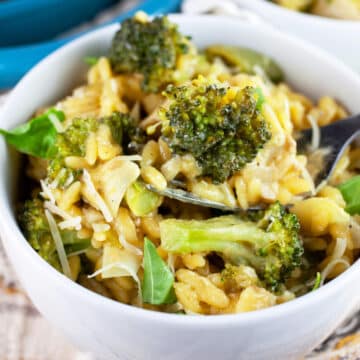
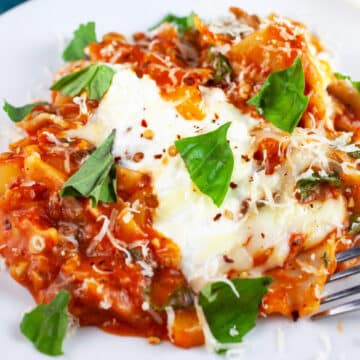
Kelly Asche
I love lasagna. The fact that I can have a healthier version that tastes just as good make this even better!
Anne
I love All of the fresh veggies in this! So delicious
Christine
Thanks, Anne! So great during the summer when all the fresh veggies are in season.